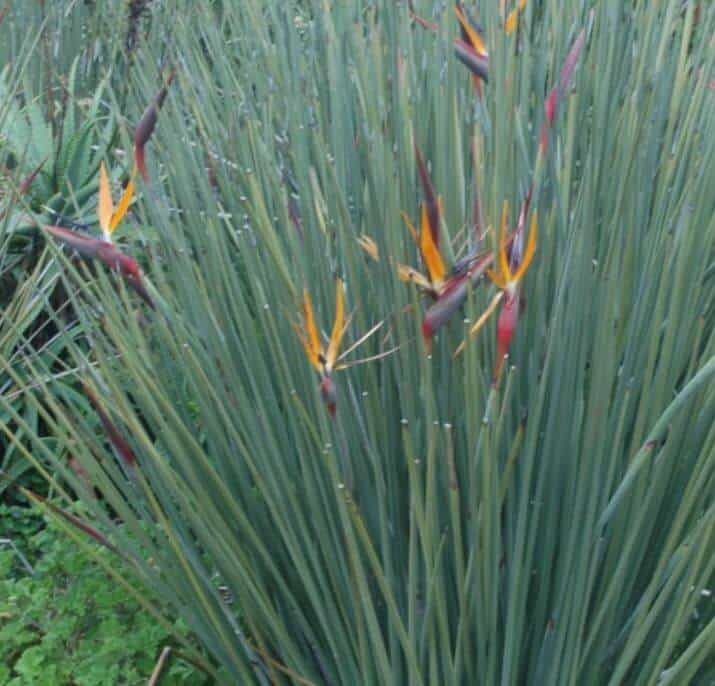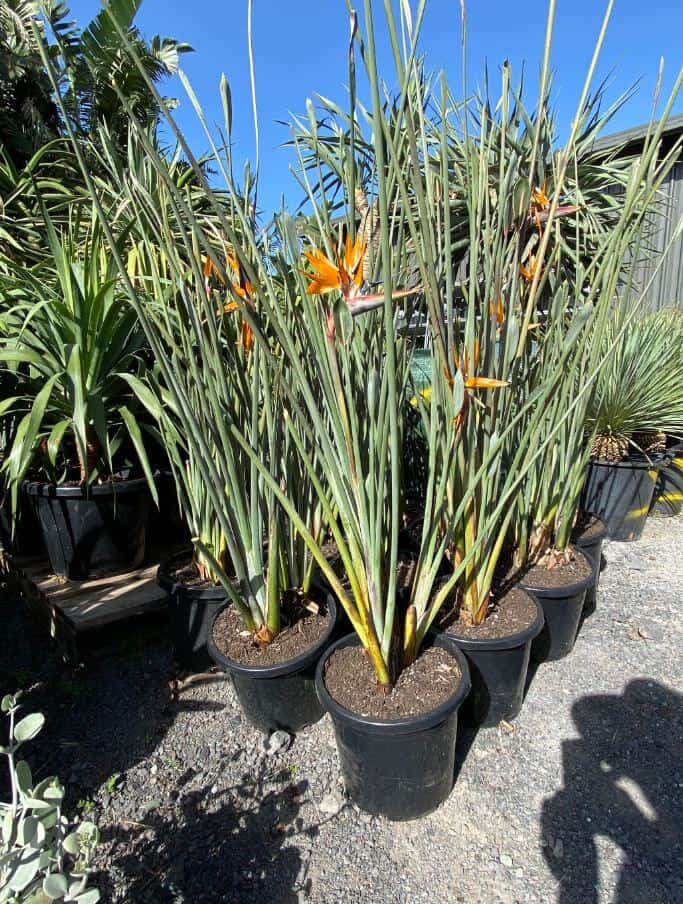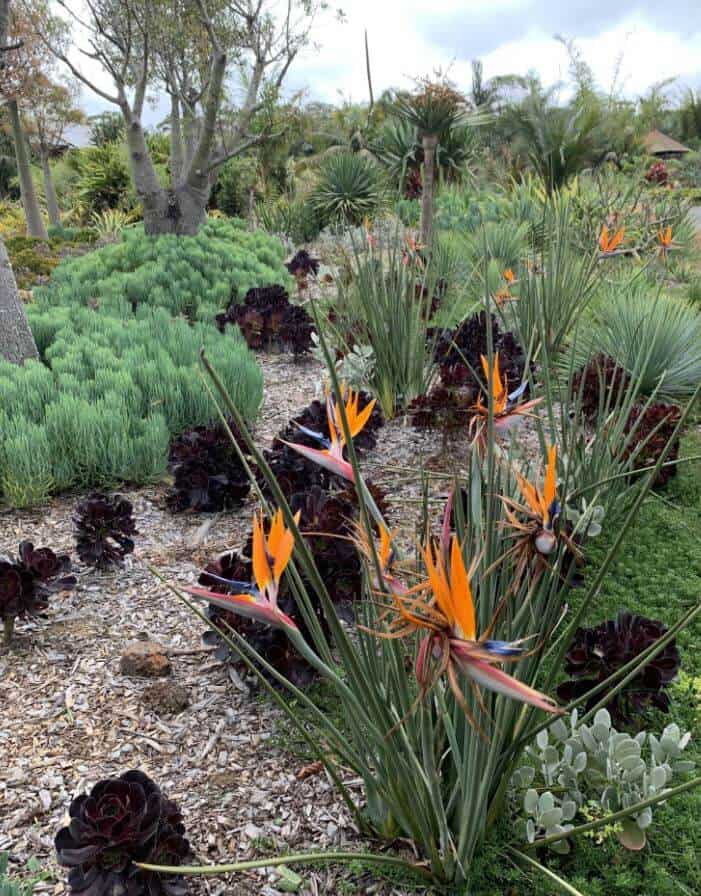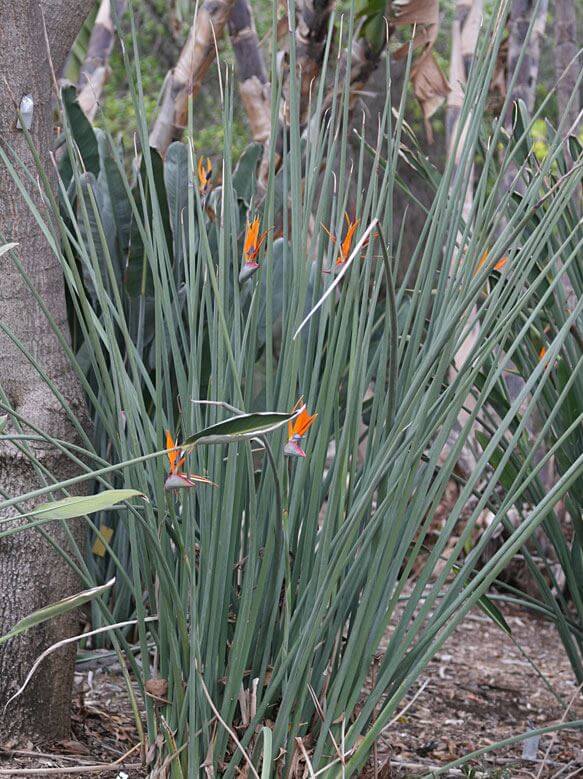Last Updated on September 15, 2023 by a Friendly Gardener
The Strelitzia Juncea is a striking garden plant native to South Africa that can also be grown indoors. It initially begins its life with very slender or narrow leaf stalks. As the plant grows, these leaves gradually become smaller until they disappear so that only a thick, stick-like stem remains, hence the description “leafless.”
As a drought-resistant plant that tolerates shade well, it is easy to care for, making it an excellent choice for beginner gardeners who find the silver-blue tint appealing. The root system is succulent-like and will grow to be large, so it needs regular repotting to impede the plant from becoming root-bound. If you see any symptoms of root congestion, repot your Leafless Bird of Paradise plant.
A defining characteristic of the Leafless Bird of Paradise plant is the stick-like stem with little to no foliage that gives the plant a straight appearance.
Leafless Bird of Paradise Care

Easy to care for, this delightful plant requires minimal but consistent care.
Soil

The ideal soil mix will be well-draining, somewhat dry, and rich in organic matter.
Light
The Leafless Bird of Paradise plant likes a sunny spot with good ventilation. A location near a sunny window with a sheer curtain is ideal, especially if your area or the window experiences intense summer sun. These houseplants do well in bright locations. When left in a spot with too little light, stems can weaken and break, contributing to a poor growth habit. This plant can be kept outside in partial shade during summer and then brought indoors at the end of October. If your plant does not appear to be thriving, consider moving it to a sunnier spot. However, intense direct sunlight does place it at risk for burning.
Water
The Leafless Bird of Paradise plant requires thorough watering during the growing season in the spring and summer months. Watering deeply allows excess moisture to drain out of container bottom holes. Water when the soil bed feels dry when touching it. As the temperatures begin to fall, watering should be reduced. If you are cultivating this plant indoors in a heated location with an environmental temperature above 60°F, check the soil regularly for dryness. Water your plant at the warmest time during the day.
Temperature

Even if the Bird of Paradise plant does have more cold resistance than many plants, it still should be kept in a spot where the environmental temperature does not fall below 40°F. It can survive temperatures as low as 32°F if it is not exposed to frost and can remain dry. Nonetheless, it is not recommended as cold can damage plant tissue.
If cultivating your plant outdoors, consider moving it inside in the fall and winter. These plants should be kept away from drafts, cold windows, or doors, even indoors in the colder seasons. Find a warm, brightly lighted perch away from heating units and vents.
Feeding
Your Leafless Bird of Paradise can benefit from fertilization using a diluted, balanced liquid fertilizer monthly during the growing season in spring and autumn. When growth slows in the summer and winter, it interrupts fertilization. Feeding is not necessary, but doing so will stimulate growth and flowering. Avoid over-feeding to protect the root system from damage.
Pruning

Leafless Bird of Paradise plants do occasionally require pruning. The best time to do so is from May through July. Remove all spent blooms, dead foliage, stems, and overly dense plant foliage. If the tips are dried out or have wilted, remove them with gardening scissors and cut all broken or dried-out stems at the plant’s base. Remove any stems that have dried completely. Avoid removing stems that are not totally dry, as this can damage the plant’s health.
Pests, Diseases, and Problems for the Leafless Bird of Paradise

Like all houseplants, the Leafless Bird of Paradise can encounter issues that place the plant’s health at risk. Here are several of the most common:
-
Root Rot
If the soil remains soggy, foliage drops off or changes color to yellow or brown, stems are soft, and there is a foul smell, you probably have a case of root rot. The soil surface may show mold traces, and roots will appear mushy and dark when examined. When a plant is overwatered, and the soil remains soggy, oxygen cannot reach the root system, and bacterium proliferates. Unhealthy root systems cannot absorb water and send it to the rest of the plant, and it will die.
To treat root rot, the plant must be removed from its pot, and damaged roots and plant parts must be trimmed off. Repot your plant in fresh, dry soil in a sterilized pot. Give it very little water for at least a week.
-
Root-Bound
If the root system completely fills the plant container, water cannot penetrate and arrive at the root system for absorption. Roots will emerge from the drainage holes and soil surface. Leaves may be yellow, and containers may crack and break.
Repot your Bird of Paradise plant.
-
Pests
Spider mites are a common threat to Bird of Paradise plants. Webbing and small insects underneath leaves are common symptoms of an infestation. You may also find spotting on foliage or damage, withering, and discoloration. These pests reproduce rapidly and can exhibit pesticide resistance.
To treat a spider mite infestation:
- Remove all affected foliage.
- Wash stems, stem joints, and both sides of foliage with a jet spray of water.
- Treat these parts with insecticidal soap, neem oil, or a pesticide. You can prevent spider mite infestations by cleaning the dust from your plant regularly and occasionally misting.

